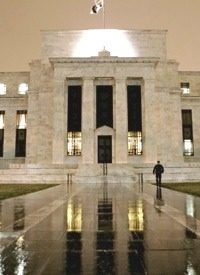
Today more people are aware of the Federal Reserve’s activities than ever before, mostly owing to the Ron Paul movement or H.R. 1207, Rep. Paul’s Federal Reserve Transparency Act, which had 317 cosponsors in the House. The spotlight on the Fed this past year did not prevent it from taking in a record-breaking $45 billion in profits last year, as recorded in public documents and reported by the Washington Post. The Fed’s largest previous profit was $34.6 billion, in 2007.
These earnings dwarf those of big banks such as Goldman Sachs, Bank of America, and J.P. Morgan Chase. What the Fed did to achieve them was engage in an aggressive bond-buying program, pushing interest rates down everywhere in an effort to stimulate economic growth. The Fed began these unconventional measures early in the financial crisis, and by the end of 2009, it owned $1.8 trillion in U.S. government debt and mortgage-related securities — up from $497 billion a year ago. A major source of the Fed’s profits was interest income — although such income bears risks. The Fed stands to lose a lot of money if it must sell those securities to reduce the money supply.
According to the report, the Fed also made money on emergency loans to banks and other firms, and on special programs to support lending — as with credit cards, auto loans, and other loans that would enable consumers to spend and businesses to survive. The Fed also increased its balance sheet to the tune of $4.7 billion in interest payments from loans to Bear Stearns and American International Group although those loans declined in value by $3.8 billion. Further gains or losses on these two bailouts are possible in 2010.
By law the Fed must return almost all of its profits to the Treasury. It may deduct operating expenses from its total earnings, such as employee salaries (Fed Chair Ben Bernanke is currently paid a salary of $199,700, with no bonuses) and the fees it charges for clearing checks and electronic payments from banks. Many economists consider this good news: a sign that the Fed’s interventions in the economy last year were successful. They credit the Fed with thwarting disaster by preventing large financial and other institutions such as AIG from going under and putting the economy on the road to recovery, although with unemployment remaining very high, mainstream economists temper their praise by noting that the recovery will be slow and painful as businesses remain reluctant to hire.
Those who would like to see more Fed transparency, however, contend that any recovery evident in government numbers cannot sustain itself unless people are returning to work in large numbers and actually producing things — in an environment of confidence where consumers and investors believe that their hard-earned money will retain its value. This is something that cannot happen in the long run if the Fed and U.S. Treasury Dept. are printing more dollars to sustain an appearance of economic growth, such as what we saw in the middle of the past decade. Fed profits are going into the Treasury in accordance with the realization that since this crisis began, the primary growth “industries” in the country have been government and central banking.
The report quotes Vincent Reinhart, an American Enterprise Institute resident scholar and former Fed official, observing, “This shows that central banking is a great business to be in, especially in a crisis. You buy assets that have a nice yield, and your cost of funds is very low. The difference is profit.”
Photo: AP Images



